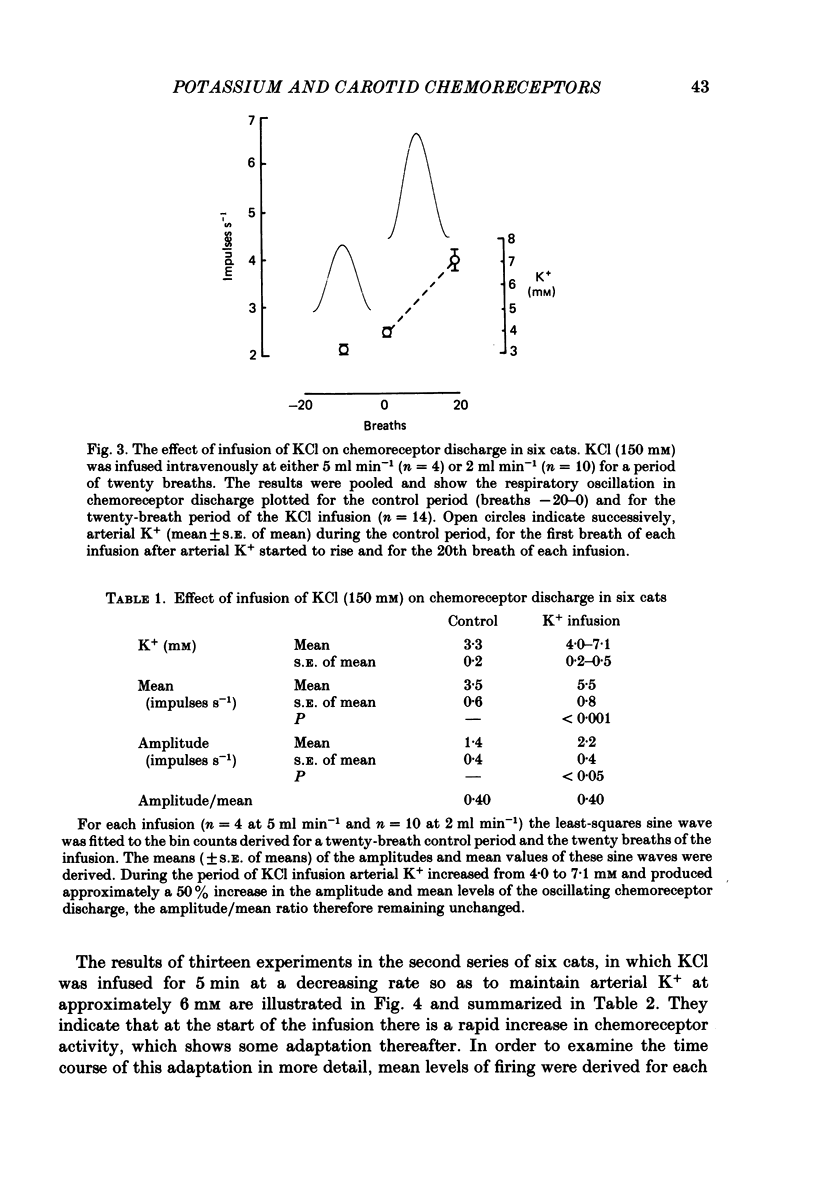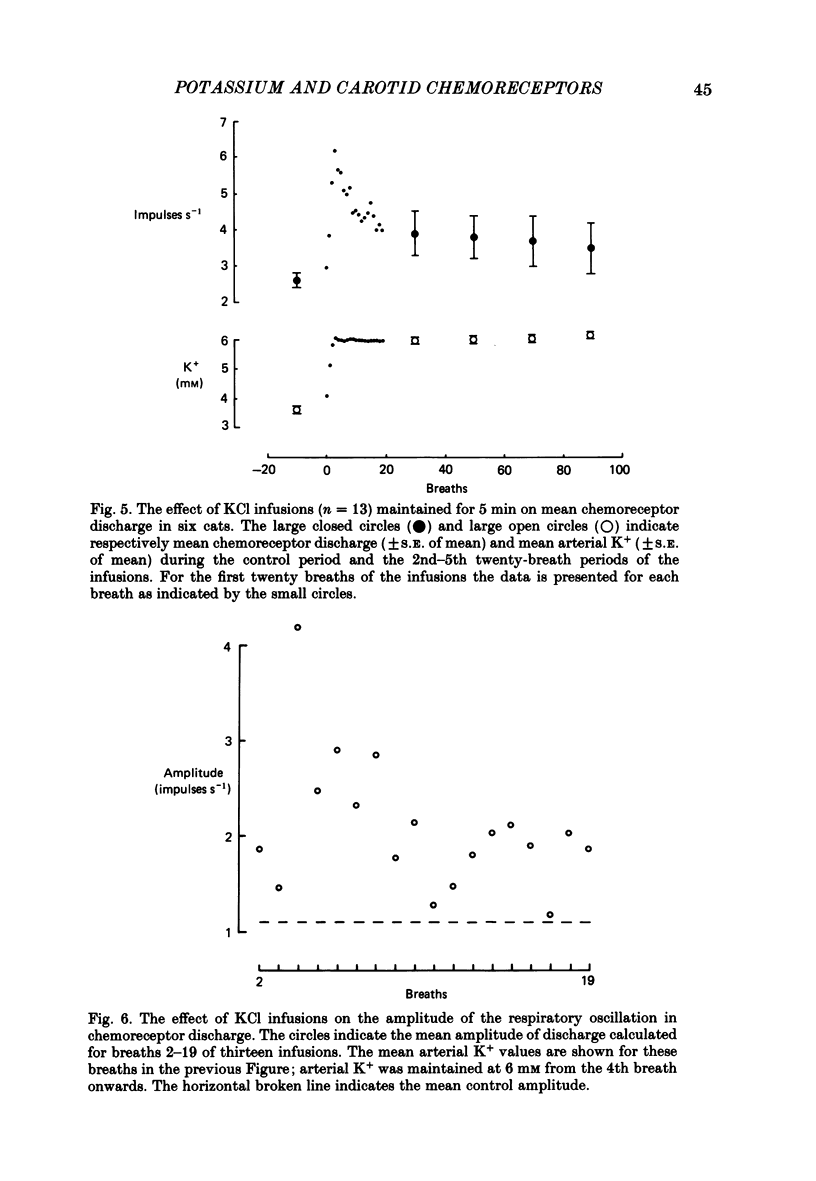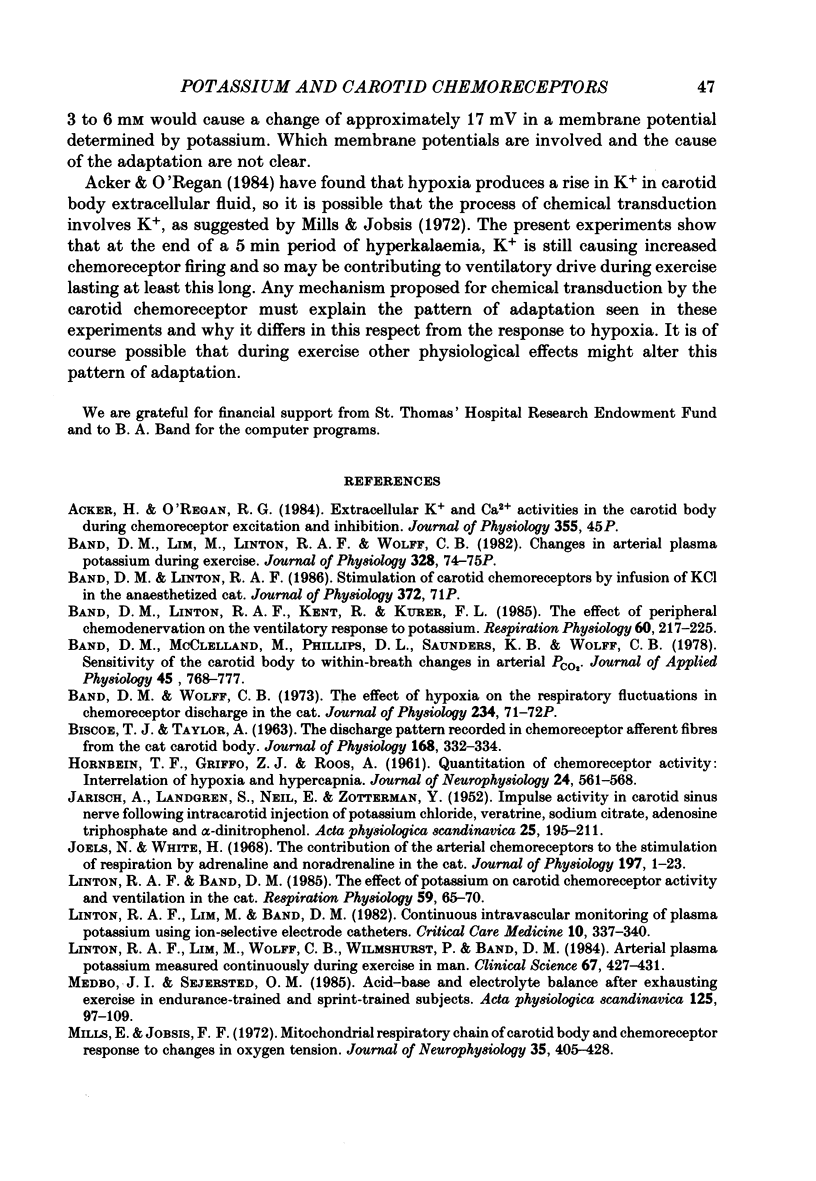Abstract
1. In exercise the arterial plasma potassium rises; we have investigated the possibility that such rises might affect the carotid body chemoreceptor. 2. Intravenous infusions of KCl were used to produce hyperkalaemia in anaesthetized cats. 3. Intra-arterial catheter tip potassium electrodes were used to monitor changes in plasma potassium. 4. The effects of 5 min infusions of KCl on afferent carotid chemoreceptor preparations were studied. 5. Infusions of KCl, which produced increases in plasma potassium similar to those occurring in exercise in man, caused an initial large increase in mean firing frequency (237% of control). A phase of rapid adaptation of this response was followed by a phase of slower adaptation, but after 5 min of hyperkalaemia mean firing frequency was still significantly greater than control. The amplitude of the breath-by-breath oscillation in frequency appeared to increase in parallel with mean frequency so that the amplitude/mean ratio remained constant. 6. We conclude that plasma potassium changes during exercise may contribute to the chemical drive to breathe.
Full text
PDF








Selected References
These references are in PubMed. This may not be the complete list of references from this article.
- BISCOE T. J., TAYLOR A. THE DISCHARGE PATTERN RECORDED IN CHEMORECEPTOR AFFERENT FIBRES FROM THE CAT CAROTID BODY WITH NORMAL CIRCULATION AND DURING PERFUSION. J Physiol. 1963 Sep;168:332–344. doi: 10.1113/jphysiol.1963.sp007195. [DOI] [PMC free article] [PubMed] [Google Scholar]
- Band D. M., Linton R. A., Kent R., Kurer F. L. The effect of peripheral chemodenervation on the ventilatory response to potassium. Respir Physiol. 1985 May;60(2):217–225. doi: 10.1016/0034-5687(85)90105-7. [DOI] [PubMed] [Google Scholar]
- Band D. M., McClelland M., Phillips D. L., Saunders K. B., Wolff C. B. Sensitivity of the carotid body to within-breath changes in arterial PCO2. J Appl Physiol Respir Environ Exerc Physiol. 1978 Nov;45(5):768–777. doi: 10.1152/jappl.1978.45.5.768. [DOI] [PubMed] [Google Scholar]
- Band D. M., Wolff C. B. Proceedings: The effect of hypoxia on the respiratory fluctuations in chemoreceptor discharge in the cat. J Physiol. 1973 Oct;234(2):71P–72P. [PubMed] [Google Scholar]
- HORNBEIN T. F., GRIFFO Z. J., ROOS A. Quantitation of chemoreceptor activity: interrelation of hypoxia and hypercapnia. J Neurophysiol. 1961 Nov;24:561–568. doi: 10.1152/jn.1961.24.6.561. [DOI] [PubMed] [Google Scholar]
- JARISCH A., LANDGREN S., NEIL E., ZOTTERMAN Y. Impulse activity in the carotid sinus nerve following intra-carotid injection of potassium chloride, veratrine, sodium citrate, adenosine-triphosphate and alpha-dinitrophenol. Acta Physiol Scand. 1952 Jun 6;25(2-3):195–211. doi: 10.1111/j.1748-1716.1952.tb00872.x. [DOI] [PubMed] [Google Scholar]
- Joels N., White H. The contribution of the arterial chemoreceptors to the stimulation of respiration by adrenaline and noradrenaline in the cat. J Physiol. 1968 Jul;197(1):1–23. doi: 10.1113/jphysiol.1968.sp008541. [DOI] [PMC free article] [PubMed] [Google Scholar]
- Linton R. A., Band D. M. The effect of potassium on carotid chemoreceptor activity and ventilation in the cat. Respir Physiol. 1985 Jan;59(1):65–70. doi: 10.1016/0034-5687(85)90019-2. [DOI] [PubMed] [Google Scholar]
- Linton R. A., Lim M., Band D. M. Continuous intravascular monitoring of plasma potassium using potassium-selective electrode catheters. Crit Care Med. 1982 May;10(5):337–340. doi: 10.1097/00003246-198205000-00012. [DOI] [PubMed] [Google Scholar]
- Linton R. A., Lim M., Wolff C. B., Wilmshurst P., Band D. M. Arterial plasma potassium measured continuously during exercise in man. Clin Sci (Lond) 1984 Oct;67(4):427–431. doi: 10.1042/cs0670427. [DOI] [PubMed] [Google Scholar]
- Medbø J. I., Sejersted O. M. Acid-base and electrolyte balance after exhausting exercise in endurance-trained and sprint-trained subjects. Acta Physiol Scand. 1985 Sep;125(1):97–109. doi: 10.1111/j.1748-1716.1985.tb07696.x. [DOI] [PubMed] [Google Scholar]
- Mills E., Jöbsis F. F. Mitochondrial respiratory chain of carotid body and chemoreceptor response to changes in oxygen tension. J Neurophysiol. 1972 Jul;35(4):405–428. doi: 10.1152/jn.1972.35.4.405. [DOI] [PubMed] [Google Scholar]


